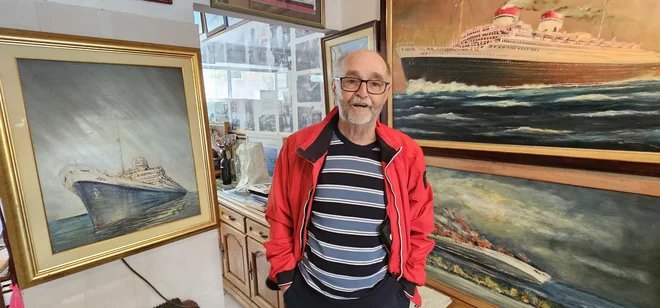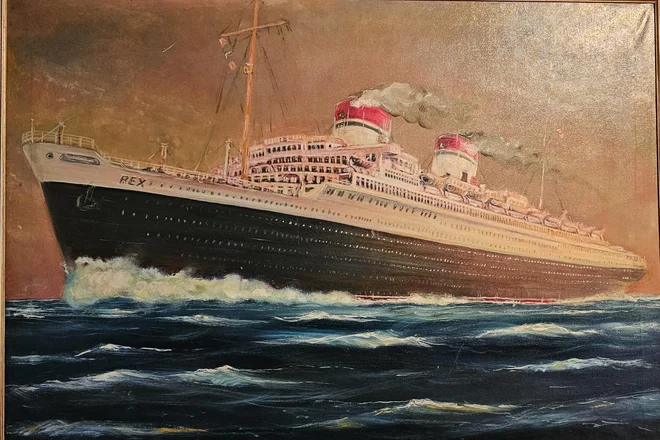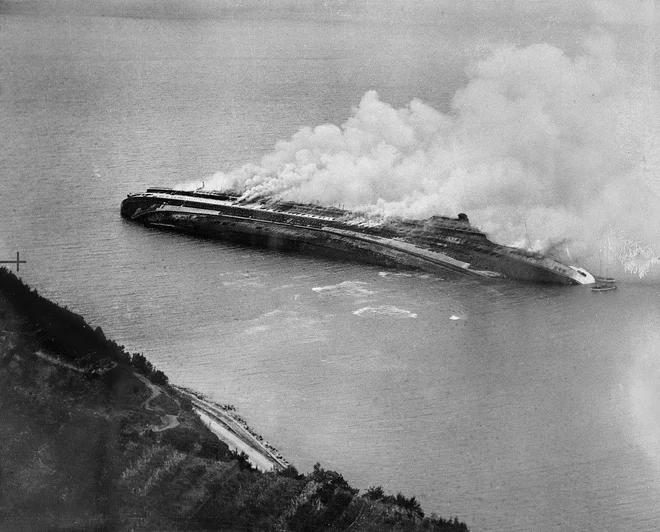The symbol of the greedy empire reigns on the seabed

If the British pilot of the royal air forces over 80 years ago along the coast between Koper and Izola would not sink the rex ships, no one would know about it today, director Federico Fellini is in Amarcord I would not process into myth, thousands of people would not take more or less valuable things, people would not tell grandchildren more and more fairy -tale stories, enthusiasts would not write books and would not ask the authorities to set up a museum … In short, without a sunken Rex, life would be more boring and dry for many.
Marjan Kralj in his Rex Photo Boris Shuligoj Gallery Izola
A long time ago, the retired ship manager Slavko Franc, one of the thousands or more who had one or the other memory of her, told us about Rex myth. “If we did not immerse the ship in our sea, we would not have any story. She would go into cut, she would turn to dust and everyone would forget about her. So we have a story. As for us and me personally, it is better for British aircraft to bomb it. «
Rex was even more luxurious than a titanic and only half a meter shorter than it, but in 1933 and 1934 the fastest ship in the world.
About a 268 -meter -long ship, which was ranked in July 1931 in Genoa, was spoken last night at a geographical evening in Croats, which is part of the world action Geopight 2025 also prepared the Hrvatini Tourist Association. On it, the evening was spoken by the Izola amateur collector, researcher, painter and gallerist about their memories of a sunken ship and subsequent research. Marjan Kralj. From Croats, from the top of the Milj hills, they were able to see part of the sea between Koper and Izola, where they still share a sunken rex on the seafloor. On the other (Italian) side of these hills, there was a shipyard at Milje (now the apartment settlement and Marina Porto San Rocco), where the same in 1931 they upgraded Rex’s sister ship Conte di Savoia, except that it was 20 meters shorter than Rex. Conte di Savoia sinked the Allies in 1943.
How attractive the ship is for the public is the fact that the Maritime Museum of Piran in 2022 printed a hefty book on Rex, which was involved by several authors and a series of witnesses, and also used a comprehensive collection of resources and documents. The book was then published in 500 copies and had been sent earlier than two years. That is why she was reprinted in 300 copies at the end of last year, her key author, a museum councilor, dr. Nadja Terčon.
A lover who was fascinated by a sunken ship
Marjan King is a credit that he was among the first in our country to be most persistently and most vocal revived and warned that authorities (as well as a tourist economy) should do much more than they are. The sunken ship was more than others because of the same name they bear.
Mussolini’s pride indicated luxury and technical excellence, but with its end pointed to the dark side of too much fascist greed and terror.
“I was a relatively good swimmer, so as a mulch, at the age of eight or nine years, I swam those about 200 meters from the shore in the mid -fifty years and climbed the creepy ironwork of a tilled ship, which was worked by the workers of the Split Brodospas in the mid -1950s – even with the help of floating crane Veli Jože – gradually cut. Autumn ironworks, « said Marjan Kralj.

So Rex was portrayed by Marjan Kralj. Photo Boris Shuligoj
Not only Marjan, a series of children, students and students, as well as other residents of the coast and fishermen, in those years perceived a submerged ship as a kind of self -service store. Children dragged old iron from the sea, preferring lead, copper, brass, including forged iron and bronze, and sold all of this on waste. What a summer month the children earned even more than parents at work. If the state claimed that Rex was the largest iron mine (cut 24,000 tonnes) in the then Yugoslavia, if the state sold the remaining oil company to the Trieste company (which did not spill into the sea or burned), the first years the locals from it took off coal, oil, pieces of iron for construction, ceramic tiles. Sanitary equipment …

Destroyed Rex in the Bay of Koper in 1944 Photo War Museum in London, Maurizio Eliseo
At the Croatian Maritime Museum, Split is kept by the capital letters of the name from the bow. Vinakoper’s directorial office still has beautifully preserved furniture (desk and two cabinets) with Rex, C. piano. Bechstein is in the lobby of Kosovel’s Cultural Center in Sežana, a rack from Rex is on a private house in Milje, and they have quite a few silver or silver containers in the Piran Museum, in the Piran Museum, a mirror. Collectors are glasses, plates, soup containers, cups, brass pieces of ship equipment … Some individuals have arranged small, private collections of Rex objects at home.
There are still 20 to 30 percent of Rex iron at the bottom.
Marjan Kralj has a gallery full of old photographs and his paintings in Izola, with a hundred ways depicting rex or something related to him. “About thirty years ago, we founded the Rex Sea Society in Izola, which operated sixty to seventy members, where we exchanged testimonies, memories, resources and data, including items. I submitted a list of all these owners and items to the Maritime Museum of Piran years ago. We also designed a special website that has attracted a lot of attention around the world, « said the interviewee, who explained to us how he accidentally met a native (Russian by nationality) on a trip around Australia, who talked about Rex. A few months later, he sent him a professional videotape from Australia with a longer documentary film clip of rex bombing.
Treasure and screw with rexa
In his theories, Marjan Kralj goes into almost fairytale waters. Namely, he claims that the Germans on Rex (as long as he was still moored in Trieste) put valuable gold, jewels and other gems, which were picked up to all camps. The Germans took these gems before they brought Rex to Izola, and according to Marjan’s theory, there is a lot of chance that he remained in the room number 87 and were picked up by partisan commanders or was so well hidden that he may still be undiscovered. This was also confirmed by persistent attempts by some foreigners who have repeatedly offered themselves to rescue or buy the ship after the war, but the Special Court of Split ruled that the ship was a naval war of Yugoslavia.

Attack on Rex along the coast between Koper and Izola 9. September 1944 Photo War Museum in London, Maurizio Eliseo
Marjan Kralj is convinced that at least one shipping screw, six meters in diameter, is still stuck in a sludge under the seabed. He revealed to us that the seabed was inspected some ten years ago by Italian researchers, because Slovenian is not convinced that the propeller is still there. The king no longer remembered (or wanted to remember) the name or institution that explored the space, although the seabed with the remaining parts of Rex has been protected as an archeological site since 2009. 80 years after the ship is immersed, at the bottom, there is an approximately 200 meters long and five -meter deep footprint. Archaeologist Dr. Andrej Gaspari He estimated that there were about 20 to 30 percent iron under Muljem, as they could not pull everything out of the sludge. Gaspari says: « It is one of the most complex heritage phenomena, both with material elements of archaeological, historical and war character and the intangible cultural heritage. »
Rex, of course, is not only a fairy tale about a once -great empire, who wanted to control the world, but also a historical document of Mussolini’s greed across colonies, the memory of the times when the impoverished Europeans from our places were massively moving to America, and at the same time the memory of the repression of this regime against everyone who was his opponents. The ship tried to enchant the world, diverting public attention to luxury and technological excellence, while in colonies and occupied countries already took place or began conquering military atrocities.
The winners are trying to
to obey the losers
Why did British pilots so standing over an abandoned and anchored ship along the Slovenian coast? Namely, as many as 123 burning missiles were fired and fired after it had already been sunk and burned, oil from it leaked from it and polluted the coast between Koper and Izola for several months. On this question, the king provided several theses. The allies were afraid that the Germans would sink the ship in front of Trieste themselves, thereby closing the entry into the port of Trieste. Another thesis is that they wanted to prevent the Germans withdrawing by boat and escaping. The third, however, was that it was a naked revenge on a cruel regime that caused so much mountain.
Rex expert Maurizio Eliseo is convinced that the winners of all wars have dipped ships, destroyed cities and did damage mainly in order to be forced to accept the help of winners after the war and thus obedient and obedient to the winners. According to him, this is the rule of all wars.







